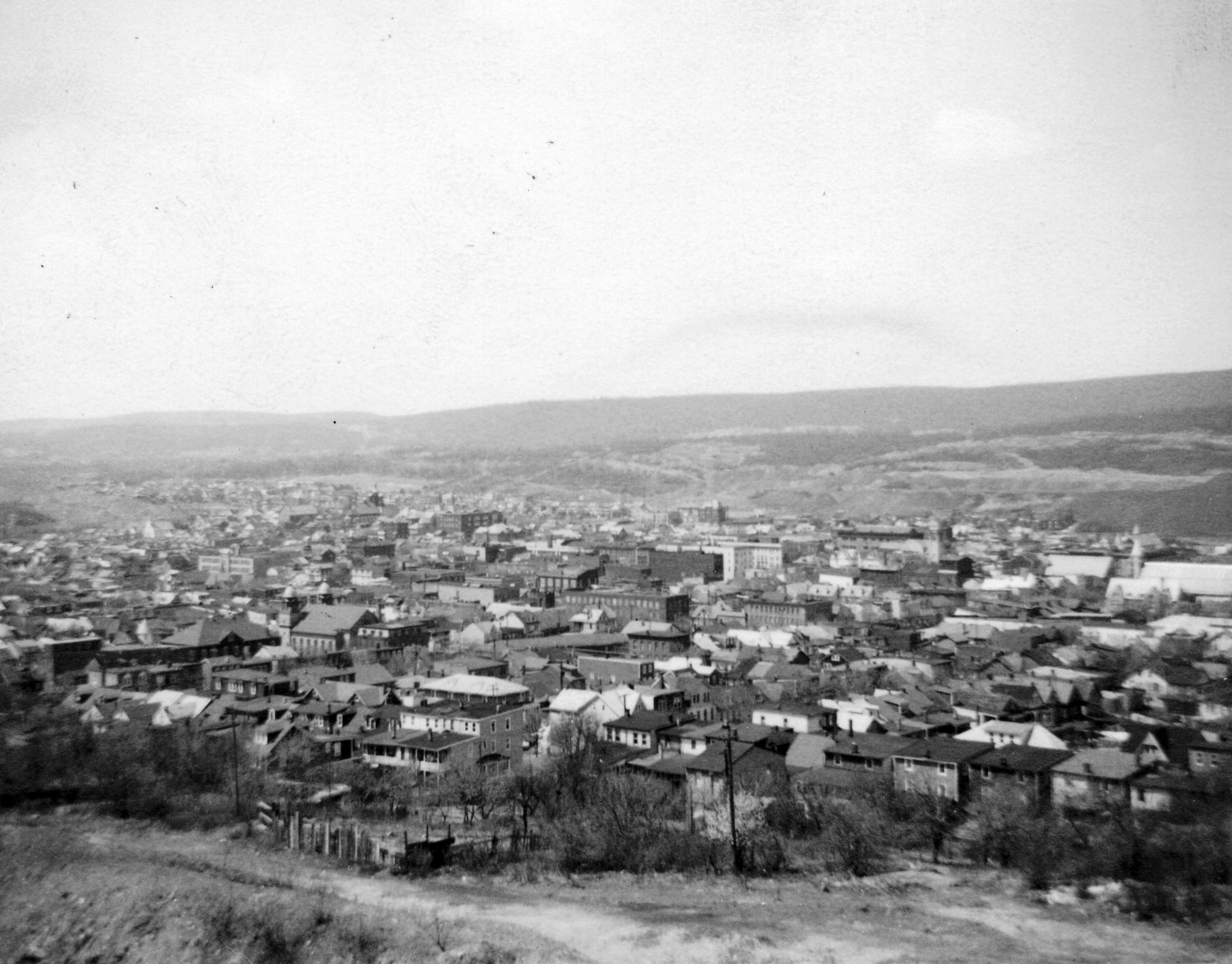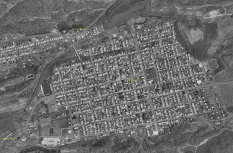
|
The photo of Mount Carmel above, looks to the Northwest and probably taken prior to 1950.
To the left is a satellite view of Mount Carmel.
Most of what I offer in photos presented here of the Mount Carmel area, were obtained from various internet sources. The best of them is probably at kanezo.com
|
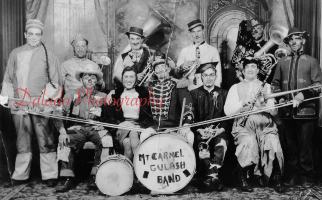
|
For a relatively small town There were few obstacles impeding their ability to provide their own entertainment
|
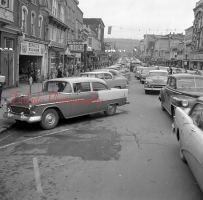
|
This is a view of Oak Street, the main shopping district, looking North from between 4th and 5th streets. Notice the filled parking spaces and the street jammed with traffic. Mount Carmel was once a vibrant, bustling community.
|
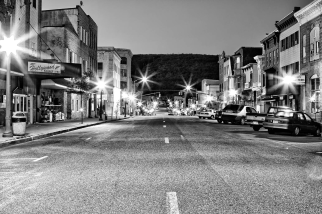
|
This view of Oak Street is typical of the inactivity that exists today. Mount Carmel depended largely on the coal industry to support its economy. When the Great DEpression hit the nation, the general reliance on coal as an energy source began itts steep decline. Then after WWIIall the garment factories an the cigar factory fled town for foriegn soils and cheaper labor costs. Consequently, it's population dwindled from an all time high of around 16,000 to about the roughly 6,000 that live there today.
|

|
One of the many coal breakers that dotted the region when coal was king. They were used to seperate coal into various sizes. Very young boys were used to pick out rocks and slate as the mining mixture slid down a ramp. It was fascinating to watch entire railway coal cars turned upside down to empty their cargo
|

|
This is a very old photo of the "breaker boys" at work in, of course, a breaker
|

|
This is not Mount Carmel. But, it is a representation of coal strip mining operations in the area that often came close to the edge of communitiess, as depicted here. There were no laws that requiered mining companies to back fill these gaping monstroties. As a result many decades past before backfilling began on a less than earneest level. But residents of these towns regarded them as a convenient place to dispose of their garbage. That refuse would sometimes catch fire, either om purpose, probably, ot accidently. If there was an exposed coal vein beneath the fire it was susceptable to catching fire and follow the vein well underground. Those fires would eventually die out or were put out. Unfortunately for the nearby town of Centralia, 2-3 miles away, gases from the underground fires seeped upward and endangered the lives of those living in Centralia. Ultimately the Federal government stepped in and demolished almost all the homes in that community. Interestingly these pits made for fascinating playgrounds for imaginative kids. Followig a snowfall it was a positive delight to slide down some embankments in cardboard boxes.
|
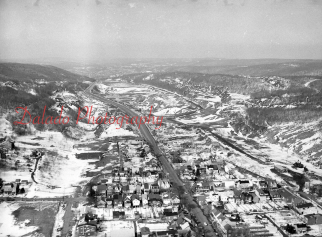
|
A view of a small portion of the West end of Centralia as it once was. None of those structures exist anymore. Mount Carmel can barely be seen in the distance in that crease between the two hills. Notice the strip mines on both sides of the road to Mount Carmel. The underground fire that ultimately led to the destruction of Centralia began on the opposite side of town.
|
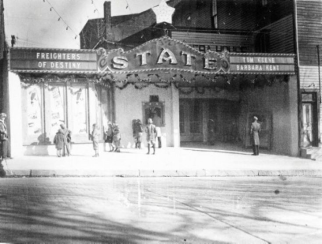
|
This is the front of the State movie theater othat once stood near the corner Third and North Hickory Streets. The U. S. Post office now occupies this spot. Because there was another far more elegant theater in town, the Victoria, it heightened the trashiness of the State. Most notorious were the restroons. They were lighted poorly, tiny by most respectable standards, gloomy, and probably not as clean as they should have been. One learned to restrain any bladder urgings. In those days it was customary to show a good to excellant movie, the same one, on Sunday, Monday and Tuesday. On Tuesday and Wednesday the offerings consisted of the most excruciatingly worse movies available. And, unfotunately attendees had to endure a double feature. Nevertheless, some excitment was often generated by bats who took up residence in the theater and terrorized attendees with acrobatic displays in front of the screen. In order to entice viewers to the mid week shows they were given one dish from a set that could only be completed by attending each week for months. Typically, on Friday and Saturday a western movie was shown, usually starring a singing cowboy. Kids loved it.
|

|
This photo from the 1920's, shows the entrance to the Victoria theater. It retained this appearance for dacades until it met the same sad fate as so many wondrous theaters in towns all across the country. This less than imposing entrance disguised the classiness of the interior. Joni Mitchell got it right when she crooned "You don't know what you got till it's gone". The theater was located midway between Maple and Oak Streets, a half block from the busiest intersection in town... all adding to the allure of seeing a movie there. Lavish MGM spectaclars and musicals along with Disney delights and clasics like "gone With the Wind" were shown here. When you exited the theater you always felt like you were entertained and enlightened rather than lectured to, horrified, embarrassed, humiliated or left wondering what in the world is going on with so much dysfunction in this country
|

|
A view from the balcony toward the stage of the Victoria theater.
My favorite seats were the front seats in the balconey.
My favorite candy from the vending machine was Ju Ju Bees, a gummy candy that I didn't chew but left slowly dissolve in mouth.
|

|
Looking out from the stage to the seating area of the Victoria theater
|

|
The lounge area in "The Vic", above the lobby and behind the balconey seating area. The rest rooms were located here.
There was another theater in town.... the Hollywood, located on Oak Street between 3rd and 4th streets. It's interior was extremely long and narror with a caverness ceiling that never made you feel sufficiently comfortable enough to really enjoy the movie. At best, attendance at this theater was feeble.
|
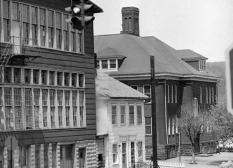
|
On the left is a garment factory on the corner of 5th and Walnut Streets. On the right is the Stevens grade school at 4th and Walnut. Grades First through Sixth grades were taught here, as was the case in the three other grade schools in town.
All the Hook children attended grade school here, conviently located just two blocks from the Hook residence. The school was demolished and the lot is now occupied by a private residance.
|
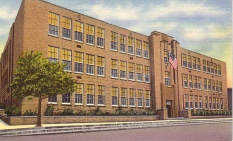
|
Here we have a post card depicting the Mount Carmel Junior High School on the corner of 4th and Vine Streets. Grades seven through nine were taught here. Since the term "Middle" school was not then generally in use it was not applicable in this case If one walked at a brisk pace, one could make it to this school from the Hook home in about twenty minutes. All the Hook children attended school here.
This sturdy structure still stands and is currently houses various borough offices
|
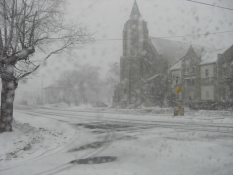
|
A snow storm partially obscures the Our Lady of Mt. Carmel Catholic church located on Market Street between 3rd and 4th Streets, adjacent to the town park.
The associated high school is to the right, and to the right of it, out of camera range, the rectory. At the rear of the church, along Lemon alley, the grade school and the convent were located. The Hooks, members of this church, were baptised here, were confirmed, confessed their sins, received their first communion, were married and before being laid to rest had a funeral mass... except the father who was a member of the Greek Orthodox Church of St. Michael on North Willow Street
|
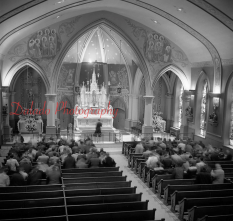
|
The appearance of the interior of the church has changed very little over time. Only the railing that seperates the altar area from the parishoners was once a heavy marble railing that was perhaps 10 inches wide.
Females, at one time were required to sit on the left side of the middle aisle and men on the right. A 9:00 AM mass was designated for children who were corralled into front pews, girls on the left, boys on the right. A Nun was positioned behind each group to curtail any inappropriate behavior.
|
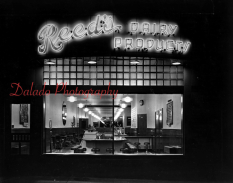
|
A night view of Reed's Dairy store located on the East side of Oak Street just a short distance from 3rd street. This plce served the most scrumptious concoction referred to as a CMP, chocolate ice cream doused with marshmallow cream and covered with chopped peanuts... among other available delectables. If one ordered a Coke the required amount of Coke syrup was pumped into your glass, followed by carbonated water and crushed ice. A few quick stirs and a straw finished it off. Some how it was tastier than the bottled stuff.
|
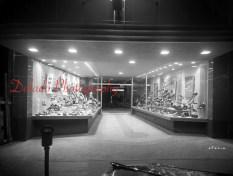
|
Miller's shoe store located on Oak Street between 3rd and 4th Streets. Boys typically had two pairs of shoes, dress shoes and another pair for every day use. A favorite style was as high as the top of the ankle and laced like a boot. a special feature was narrow pocket on the outer edge of one shoe designed to hold a pocket knife. This was fantastic because no self respecting boy would ever leave their house without their knife... even if they were bound for school. Those who concoct today's societal norms would be apoplectic. |
>
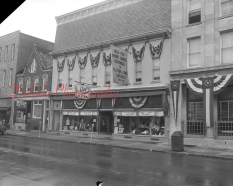
|
Stief's clothing store on the East side of Oak Street just above 3rd. As then end of Advent approached kids were sure to be hustled to Stief's to assure that they were properly attired for Easter. The store of choice for every day wear was J. C. Penny
|
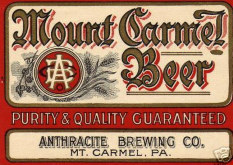
|
Beer was brewed throughout the region until about the 1950's when the big breweries, mainly in the mid West, began advertising extensively on TV. They walloped many smaller operations throughout the country. Only Pottsville can claim a they have a survivor.
|

|
One the the more iconic structures in Mount Carme, (excluding its fabulous churches), housed the Antracite Fire Company. Situated on the edge of the town park, along busy state route 61, and visible for many blocks while driving East on 3rd Street, this building was known to many throughout the area. There were four fire companies in Mount Carmel, one in each ward. While the competance of the member fire fighters can't be questioned, many would think that housing large barrooms on their 2nd floors... can be. The consumption of alcohol in those bars often exceeded many saloons and social clubs. Yet another coal region oddity.
These fire companies also had bingo nights and dances.
|
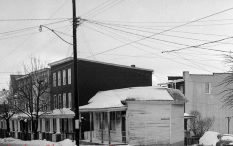
|
Gambling was illegal in the state. Yet, if desired, one could easily find a seat at a poker table at a site such as this little shack at the corner of Seventh and South Turnpike Streets. Bookmakers freely knocked on neigherhood doors as a convenience for those regular bettors, and those who were not regarded as racketeers but... were. There was a lottery run out of a building on 4th street just East of Oak Street. The first prize on Saturday was a thousand dollars which helped draw people to that downtown area from in and out of town. As a result Catholic church confessionals were exceptionally over burdened with handing out hefty penances.
|

|
There were garment factories in the Northeast and Southest ends of town. They produced quality stuff. Such factories owe their existance to owners in places like New York city moving their operations to mainly Northeast Pennsylvania to take advantage of cheaper labor costs. Ironically almost all closed after the 1950's to seek lower operational costs in foreign countres. In was devestating after the garment workers union was securing good wages and working conditions for its members
|
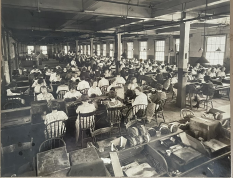
|
Women working in the General Cigar factory. This half block long four story building was located at the corner of 5th and Hickory Streets It began operations in the early 1900's and provided employment for, mainly women in the area, for 55 years. It's amazing how many woman claimed they worked here, either briefly or for an extended number of years. Many started as 12 year olds. As with many other factories in the area, General Cigar moved its production processes off shore.
A huge exhaust pipe on the 5th Street side of the buildig provided, for passer-bys, the brief pleasant experience of tobaccco leaf odors.
|
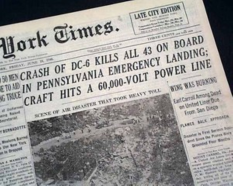
|
As a foolish teenager, I went to this crash site about four hours after it happened. It was headline news across the country.
Gruesome insufficiently describes the carnage.
The closest community to this tragic event was actually Wilburton
|
